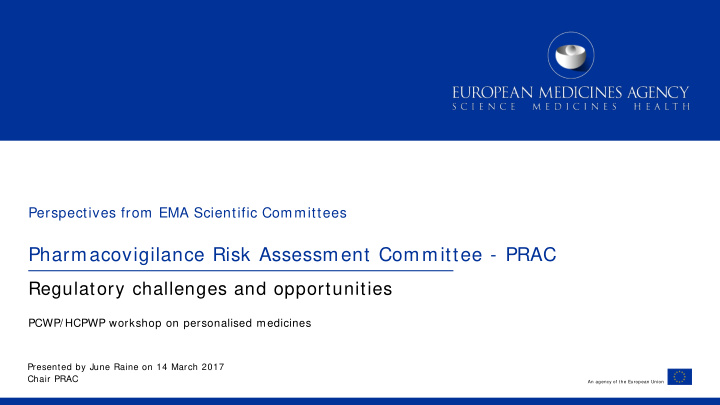



Perspectives from EMA Scientific Committees Pharmacovigilance Risk Assessment Committee - PRAC Regulatory challenges and opportunities PCWP/ HCPWP workshop on personalised medicines Presented by June Raine on 14 March 2017 Chair PRAC An agency of the European Union
Pharmacovigilance Risk Assessment Committee All aspects of the risk management of the use of medicinal products including the detection, assessment, minimisation and communication relating to the risk of adverse reactions, having due regard to the therapeutic effect of the medicinal product, the design and evaluation of post-authorisation safety studies and pharmacovigilance audit
PRAC’s aim is excellence in public health protection PV legislative fram ew ork Science & PV capacity & m ethodologies com petency
PRAC’s key developments shaping medicines evaluation Proactively investigating drug safety signal detection throughout lifecycle , wider definition of adverse reaction including error, post-authorisation studies Responding to safety & benefit risk issues risk-proportionate decisions to rigorous timescales, effectiveness of risk minimisation Driving forw ard a new era in transparency prompt access to information on activities I ncreasing involvem ent of stakeholders health professionals, patients and public
PRAC’s “Road Map” to personalised drug safety EU Guideline on pharmacogenomics in pharmacovigilance published November 2015
What is scope of PGx in PV guideline? Pharm acogenom ics in pharm acovigilance guideline addresses influence of PGx on PhV activities: • how to evaluate the PhV related issues for MPs with PGx associations • how to translate results of evaluation to appropriate treatment recommendations in product information for patients and HCPs Emphasis is on particular aspects of PhV activities & risk m inim isation m easures related to medicines in genetic subpopulations Types of genom ic biom arkers relevant for PhV are illustrated with examples… 5
Examples in PGx in PV guideline Rate of drug m etabolism Risk status for ADRs Codeine CYP2D6 Abacavir- HLA-B* 5701 Tamoxifen CYP2D6 Flucloxacillin HLA-B* 5701 Clopidogrel CYP2C19 CBZ HLA-B* 1502 Celecoxib CYP2C9 CBZ HLA-A* 3101 Warfarin CYP2C9 Phenytoin HLA-B* 1502 Thiopurine TPMT Allopurinol HLA-B* 5801 Irinotecan UGT1A1 Warfarin-VKORC1 Statin SLCO1B1 QT-HERG 6
Abacavir hypersensitivity Evidence -double blind prospective RCT Genomic biomarker: HLA-B*5701 (all races) Allele frequency 6-8% in Caucasians, 1% in Asian pops, (ethnicity): less than 1% in African populations Issue-ADR (severity, Hypersensitivity, serious frequency, etc): Prevalence phenotype: - 8% Risk of ADR: 48% to 61% of patients with allele vs 0% to 4% of patients without allele Data source (incl. study Prosp. CT and others design, etc): PPV 55 % NPV 100% Label (sections in SPC): 4.1 7
Codeine analgesia in children, serious opiate toxicity Evidence – spontaneous cases, data on prevalence of ultra-rapid metabolisers
5-fluorouracil and capecitabine toxicity Evidence from 2 meta-analyses linking DPYD variants to severe toxicity, leading to recommendations for dose reduction for initiation? Dose recommendations for DPYD variants Metabolic pathway of fluoropyrimidines 9
Regulatory challenges Genom ic data collection in post-marketing phase Level of “certainty” on the evidence I m plem entation of use of pharmacogenomic biomarkers Measuring effectiveness of the risk minimisation activities Understanding the perspectives and views of patients and HCPs 10
Opportunities for pharmacogenomics in pharmacovigilance Use of all available data – including “big data” Registries initiative under way at EMA Biobanks , capability to link genetic material & electronic health records Evaluating im pact of regulatory action and activities – PRAC strategy Engaging even more actively with patients, the public and healthcare professionals 11
PRAC focus on evaluating impact of regulatory action 12
Involving patients & public in decisions Interaction with patient and health profession organisations by PRAC has so far been arranged ad hoc EMA has consulted widely on arrangements for public hearings for safety referrals First public hearing will be held later in 2017
Key questions Are PRAC’s activities sufficiently systematic on PGx in PV? Are we utilising the guideline on PGx in PV optimally? Are we setting the evidential bar too high to support making recommendations? Could PRAC be more proactive in stimulating research in PGx? Does current product information adequately present PGx information to support individual decisions on benefit risk? Can PRAC collaborate more in support of personalised medicines? 14
Recommend
More recommend